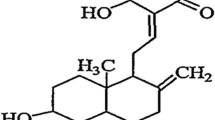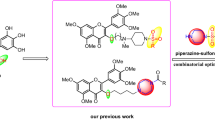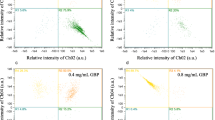Abstract
β-Glycyrrhetinic acid isolated from Glycyrrhiza glabra had an antibacterial activity of 7.6 and 12.5 μg ml−1 against Bacillus subtilis and Staphylococcus epidermidis without causing hemolysis of human erythrocytes, whereas it was not inhibitory against Escherichia coli, Proteus vulgaris and various fungi. Confocal microscopy showed that β-glycyrrhetinic acid was located within the bacteria but had not caused membrane disruption. It then inhibited synthesis of DNA, RNA and protein.
Similar content being viewed by others
References
Abe H, Ohya N, Yamamoto KF, Shibuya T, Arichi S, Dashimas S (1987) Effects of glycyrrhizin and glycyrrhetinic acid on growth and melanogenesis in cultured B16 melanoma cells. Eur. J. Cancer Clin. Oncol. 23: 1549-1555.
Capasso F, Mascolo M, Autore G, Duraccio MR (1983) Glycyrrhetinic acid, leucocytes and prostaglandins. J. Pharm. Pharmacol. 35: 332-335.
Haraguchi H, Oike S, Muroi H, Kubo I (1996) Mode of antibacterial action of totarol, diterpene from Podocarpus nagi. Planta Med. 62: 122-125.
Kubo I, Taniguchi M (1988) Polygodial, an antifungal potentiator. J. Nat. Prod. 51: 22-29.
Lee DG, Shin SY, Maeng C-Y, Hahm K-S (1998) Cecropin Amelittin hybrid peptide exerts its antifungal effects by damaging on the plasma membranes of Trichosporon beigelii. Biotechnol. Lett. 20: 211-214.
Merrifield B (1986) Solid phase synthesis. Science 232: 341-347.
Mori A, Nishino C, Enoki N, Tawata S (1987) Antibacterial activity and mode of action of plant flavonoids against Proteus vulgaris and Staphylococcus aureus. Phytochemistry 26: 2231-2234.
Omura S (1986) Philosophy of new drug discovery. Microbiol. Rev. 50: 259-279.
Sabanero M, Quijano L, Rios T, Trejo R (1995) Encelin: a fungal growth inhibitor. Planta Med. 61: 185-186.
Steward PM, Wallace AM, Valentino R, Burt D, Shackleton CHL, Edwards CRW (1987) Mineralcorticoid activity of liquorice: 11-beta-hydroxy-steroid dehydrogenase comes of age. Lancet 2: 821-824.
Tokuda H, Ohigashi H, Koshimizu K, Ito Y (1986) Inhibitor effects of ursolic and oleanolic acid on skin tumor promotion by 12-Otetradecanoylphorbol-13-acetate. Cancer Lett. 33: 279-285.
Wang ZY, Agarwal R, Zhou ZC, Bickers DR, Mukhtar H (1991) Inhibition if mutagenecity in Salmonella typhimurium and skin tumor initiating and tumor promoting activities in Senecar mice by glycyrrhetinic acid: comparison of 18α-and 18β-stereoisomers. Carcinogenesis 12: 187-192.
Author information
Authors and Affiliations
Rights and permissions
About this article
Cite this article
Kim, H.K., Park, Y., Kim, H.N. et al. Antimicrobial mechanism of β-glycyrrhetinic acid isolated from licorice, Glycyrrhiza glabra . Biotechnology Letters 24, 1899–1902 (2002). https://doi.org/10.1023/A:1020900124997
Issue Date:
DOI: https://doi.org/10.1023/A:1020900124997




